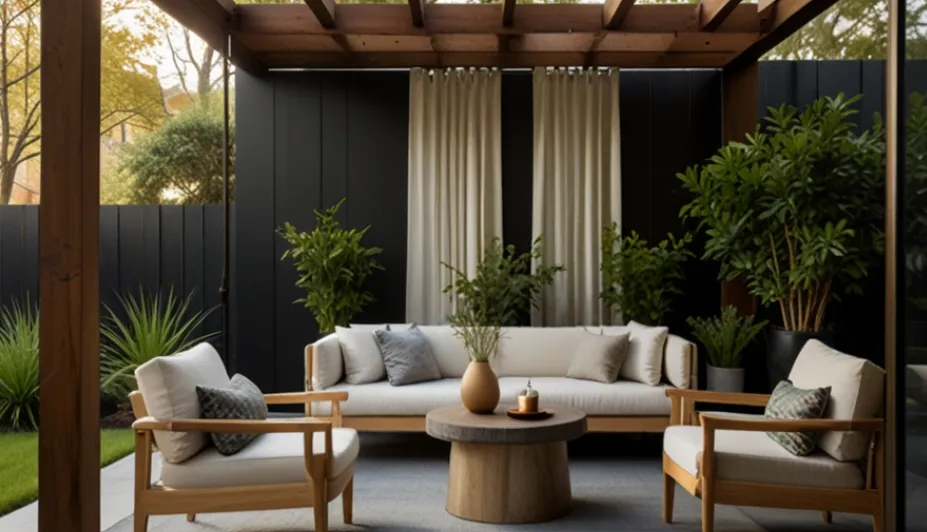The sun is shining, flowers are in full bloom, and all this beautiful weather finally invites us to enjoy our outdoor spaces. However, if you have limited space, it may not seem like the most comfortable place to relax. So, how do you make the most of your available area?
It just takes a few design tricks. Whether by adding tall plants or using lighter colors, there are many ways to make a small patio or small balcony seem larger than it is.
Content
Below, we consulted two designers to learn their best tips for giving a small outdoor space the impression of grandeur, so you can stretch out and savor your outdoor activities to the fullest.
Meet the Experts
Add Vertical Elements
Adding vertical elements, particularly taller plantings or tree canopies, can increase the perceived volume of the space.
“If space allows, trees can create a sense of enclosure and intimacy, forming nested but connected spaces that feel like destinations, even in compact gardens,” says Nahal Sohbati, co-founder of Topophyla.
You can add architectural elements like trellises, pergolas, or large planters.
“This not only draws the eye upward, creating an illusion of height, but also optimizes usable space without increasing the footprint,” says Kevin Lenhart, design director at Yardzen.
Want more design inspiration? Sign up for our free daily newsletter to discover the latest decorating ideas, designer tips, and much more!


Maintain a Cohesive and Light Palette
Creating visual continuity in your outdoor space allows it to flow better and minimizes distractions. This can be accomplished with a cohesive palette of materials and colors across flooring, furniture, and planters.
“This cohesion reduces visual clutter, allowing the eye to move freely and perceive the space as more open,” explains Lenhart.
Lighter colors, in particular, help brighten a space, creating a sense of openness and airiness.
“The same principle applies to planting design—including layers of lighter-toned foliage can enhance depth and add visual interest, making the space feel more expansive,” says Sohbati.


Opt for Layered Plantings
While you want to choose similar furniture colors, your plantings should be more varied, especially regarding their shapes.
“A playful mix of foliage textures, sizes, and colors adds richness and dimension, drawing the eye through the space and making it more dynamic,” specifies Sohbati. “Avoid using uniform or monochromatic texture in plantings, as this can make the space look flat and boring.”
Lenhart also suggests implementing layered plantings so your space looks more animated.
“Arrange plants in tiers, from low groundcovers to medium-sized shrubs to larger vertical elements, to create depth and direct the eye outward,” he says.

Look Beyond the Boundaries
If your garden offers views beyond your home’s boundaries, Lenhart suggests highlighting them—and using them to your advantage.
“Use lighter plantings and see-through fencing on the perimeter to create a smooth transition between your space and the surrounding landscape, effectively ‘borrowing’ landscapes to expand the visual field,” he says.
Sohbati agrees that directing the eye toward exterior viewpoints can deepen the mental map of the space.
“Soften boundaries with layered trees, vines, or hedges to blur the edges and invite the eye to wander,” she suggests. “This approach creates a more garden-like ambiance, encouraging exploration rather than delineation.”

Integrate Curved Pathways
Similarly, curved pathways promote a sense of wandering, especially in gardens or landscaped spaces.
“Integrating gentle curves into paths or flower beds adds movement and a sense of exploration, tricking the brain into perceiving more space,” explains Lenhart.
Decorate with Lightweight Furniture
Lightweight, easy-to-move furniture can be particularly useful in modestly sized gardens.
“They allow for easy reorganization throughout the day and can adapt to different uses or users,” says Sohbati. “Bulky furniture tends to visually and physically dominate small spaces, making them feel overcrowded and limiting their functionality.”
Low-profile designs with open frames or thin silhouettes can also help maintain views of nature and the surrounding landscape. Meanwhile, built-in seating or multifunctional pieces can give your small outdoor space more customized proportions.
“Built-in seating can be tailored to specific areas, maximizing utility without creating a cluttered layout,” says Lenhart. “Benches with built-in storage, stools that also serve as side tables, and expandable dining tables [also optimize space].”

